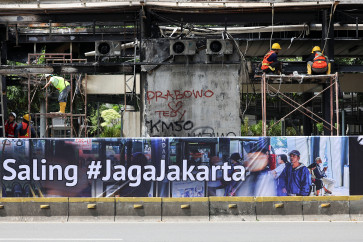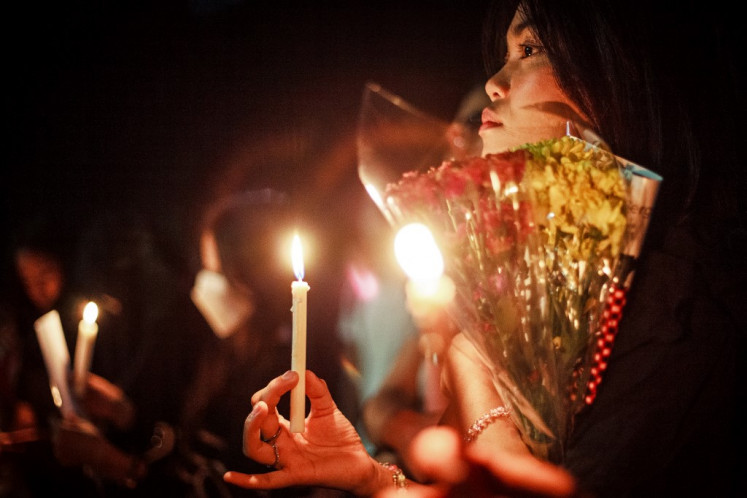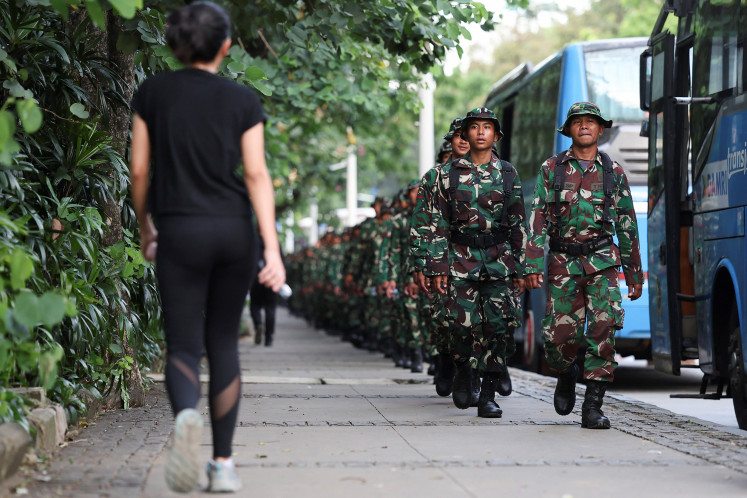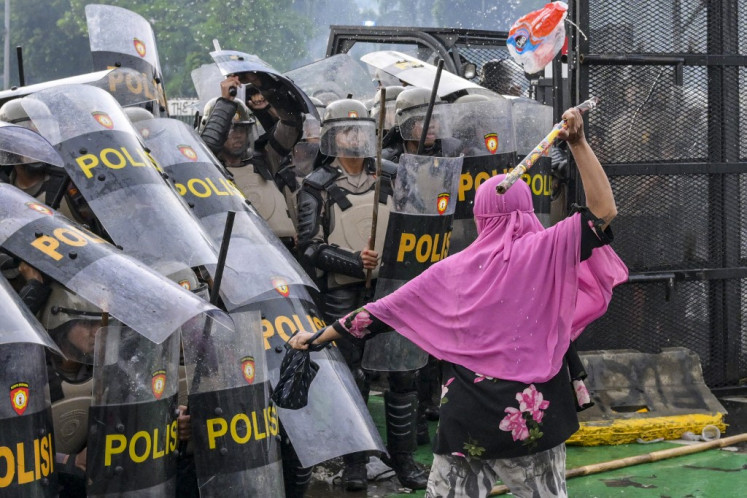Popular Reads
Top Results
Can't find what you're looking for?
View all search resultsPopular Reads
Top Results
Can't find what you're looking for?
View all search resultsProud to be Javanese
Past and present: Jaran Kepang captures members of the Javanese community in the Netherlands performing a traditional performance with mask and costume
Change text size
Gift Premium Articles
to Anyone
P
a href="http://">Past and present: Jaran Kepang captures members of the Javanese community in the Netherlands performing a traditional performance with mask and costume. Isabelle TolhurstLast Thursday’s book and exhibition opening entitled “Migration and cultural heritage: Stories of Javanese in Suriname, Indonesia and The Netherlands” was more than just a fleeting presentation of research and cultural artefacts.
The evening at Erasmus Huis provided an insight to over 150 years of history on Javanese migration, a detailed explanation of cultural heritage and identity, and for some, a little lesson in geography as well.
Though a small nation, and one that rarely features in global headlines, Suriname, in northern South America, sits atop its giant neighbor Brazil and is cushioned neatly between Guyana and French Guiana. More importantly however, it has also been the site of much Dutch and Javanese migration.
A series of well-researched and respected speakers addressed a full house, providing the historical backdrop of each nation and contextualizing the exhibition.
Collectively they discussed the benefits and negative elements of migration by the Javanese into the Netherlands and Suriname. Dialogue about the division of society based on cultural and religious lines, and the economic hardship and emotional breakdown endured by Javanese communities resonated powerfully with the audience.
Rosemarijn Höfte, coordinator and researcher at the KITLV (Royal Netherlands Institute of South-East Asian and Caribbean Studies), upon presenting her body of research, insisted that “geography is of the utmost importance” when it comes to understanding how cultural heritage is lived and transferred.
Her commentary was met with a multitude of approving nods. Höfte also acknowledged the influence of World War II and Indonesian independence on migration trends.
Ibu Aswatini, another researcher who has spent many years detailing the movement of Javanese people, proceeded to introduce a now fully functioning online database.
It serves to disseminate information and facilitate education programs about such migration, but also holds historical records of many Surinamese immigrants and workers, so that families are able to accurately map the genealogy and movement of past generations.
“Anyone interested in Suriname should know about this database,” Ibu Aswatini insisted.
After the audience had been briefly, but no doubt quite thoroughly educated on the exodus of the Javanese, the exhibition was officially opened.
The KITLV and the Embassy of the Republic of Suriname both contributed multiple photographs, maps and diagrams that unitedly paint the history of Javanese migration, recreate a history of cultural heritage in Suriname, but also detail the various ways in which the Javanese Diaspora in the Netherlands continue to express their culture.
The work of photojournalist and artist Matte Soemopawiro was also a major feature of the exhibition. Matte has lived in the Netherlands for over 25 years, and remains driven by the magic of spontaneity, or more simply being in the right place at the right time.
“Unique moments pass you by only once,” he says.
Matte also revealed his spring of inspiration, and shared his sentiments on Javanese heritage.
“Essentially I did it because I’m Javanese…and though my Mum was very traditional, for me, such tradition was non-existent. After she died, I felt as if I lost something, like a part of my identity…also, when I created this series, I felt my mother again. And I feel happy for that. Quite honestly, I know very little about Javanese culture, but I’m try to learn.
“It’s also a wake up call…to remind everyone not to forget their identity and origins. I’m proud that I’m Javanese. Initially I was not proud; we were treated as people of lower status,” he concluded.
When asked about his favorite piece, the choice was effortless. Pacing quickly to the image, Matte explained that Jaran Kepang depicts the past co-existing with the present.
The photo captures members of the Javanese community in the Netherlands performing a traditional performance with mask and costume. Matte delighted in the portrayal of the ancient dance existing in the modern streets of the West, and explained how it could instill the sense of “a culture living forever,” in the viewer.
Deputy director at Erasmus Huis, Jeroen Gankema, also spoke about the artistic choices and
how he regarded the event as an overall success.
“We picked 30 out of around 40 pictures and wanted to share an impression of what the Javanese culture is now in the Netherlands but also in Suriname. We’re happy that their rituals and traditions have been caught by the photographer, who is himself Javanese and of Surinamese descent. He fits very well into this project,” he said.
“I think we had a good target audience, and there were strong responses to the Javanese dimension.
I think people really were touched by the stories. And many young people too, which is always great to see.”
“Migration and cultural heritage: Stories of Javanese in Suriname, Indonesia and The Netherlands”.
The aforementioned database can be found at the following URL: http://www.stichji.javanen.nl/
and has information in both Dutch and English.
Photo exhibition
Erasmus Huis
Jl. H.R. Rasuna Said Kav. S-3
Kuningan, Jakarta
Until Feb. 18
Free admission










